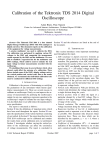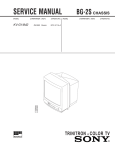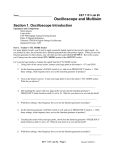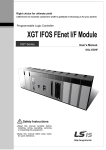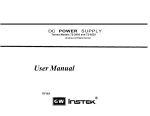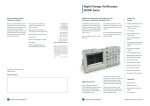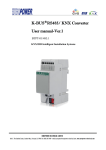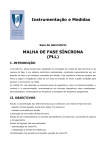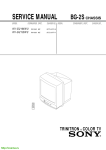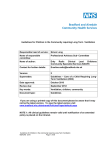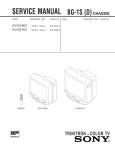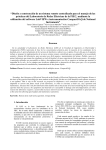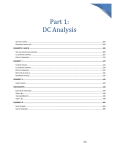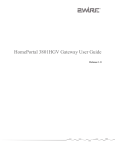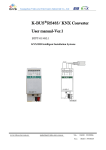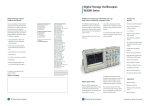Download Preliminary Study on Power Consumption of Typical Home Network
Transcript
Preliminary Study on Power Consumption of Typical Home Network Devices Thuy Nguyen, Adam Black Centre for Advanced Internet Architectures, Technical Report 071011A Swinburne University of Technology Melbourne, Australia [email protected], [email protected] Abstract—This document reports on our preliminary study of the power consumption of typical household networking equipment under different operational modes. Three ADSL modems are studied: Cisco 837, Linksys AG041 and Linksys WAG54G. We consider each modem’s power consumption when it is being in the Minimum Load (powered on with no physical ADSL/Ethernet connections), Idle (powered on with ADSL/Ethernet connection but no user-ininitated traffic) and Loaded (with a high packet per second link load and loaded NAT table). For the ADSL/Wireless Linksys WAG54G modem, we also consider its power consumption when receiving and transmitting packets. In the Minimum Load, the Linksys AG041 consumes the most power, followed by the Cisco 837. The Linksys WAG54G consumes the least power. A loaded link tends to increase the power consumption of the Cisco 837 modem, and reduce that of the two Linksys modems compared to the Idle state. Loaded NAT tables increase the power consumption of the two Linksys modems, yet slightly reduce that of the Cisco 837. Transmitting using the wireless interface of the Linksys WAG54G with a high bit rate consumes significantly greater power than receiving traffic. Also in this document, our test methodologies, testbed setup, equipment specifications and equipment calibration are described. I. I NTRODUCTION The Internet has been growing very fast over the years with increases not only in the number of its users, hosts and servers, networks and autonomous systems, but also in volume and types of traffic. Traditional Internet applications, such as electronic mail, file transfer, and staticcontent web sites, are being joined by newer services such as IP telephony, real-time interactive audio and video conferencing, streaming of multimedia content, online games, and electronic commerce. This creates a wide range of household and business Internet uses. This CAIA Technical Report 071011A expanding trend is driven further by the rapid development of computing and communications in portable forms (e.g. laptop computers, PDAs, cellular phones), along with new modes of Internet access (e.g. from dial-up to broadband to possible optical access networks in the future), which potentially will spawn more new applications and services. However, this rapid development raises an issue of the energy consumed to power the Internet. Roth et al. [1] studied the annual electricity consumption of nonresidential office and telecommunications equipment in the U.S. The study found that the office and telecommunications equipment consumed up to 97TWh of electricity in 2000, and the key IT equipment (personal computers and their monitors, server computers, computer networks, telephone networks, and UPSs) accounted for more than 70% of the total. It is estimated that the Internet could cause from 2% to 5% of Germany electricity consumption in 2010 [2]. IT equipment also consumes about $6 billion of electricity every year for the U.S. [3]. While most previous work focuses on measuring energy consumption for non-residential networking devices (e.g [4] [1]), there have not been many studies focusing on the actual energy consumption of household networking equipment. Over the last few years, we have witnessed the rapid penetration of broadband residential Internet services. Subscriptions to broadband Internet services rose 20% in 2006 to exceed 50 million US households. It is estimated that the trend will continue to surpass 60 million households by the end of 2007, accounting for 55% of all US households [5]. South Korea became one of the worlds broadband leader with 67% of household having broadband Internet access in 2002 [6]. Similar broadband penetration trends have been seen in many other countries (e.g. China, France, Japan [7]). October 2007 page 1 of 17 In this study we focus on exploring the power consumption characteristics of some common consumer networking devices, especially ADSL modems and 802.11 wireless LAN devices. We’re looking at how energy efficient these devices are, considering that they are being used by millions of households around the world, and typically left powered on 24x7. We are also interested in whether different network usage patterns cause changes in the power consumption of these devices. Examples of different network scenarios include when the device is at Minimum Load, Idle or Loaded - with high link load in terms of packet rate and loaded NAT table - and when the wireless modem transmitting or receiving traffic over the wireless interface. This document provides a summary of our studies so far, including: problem definition, test methodologies, description of different test scenarios and expected outcomes, actual test outcomes with our analysis and critique. Finally we provide recommendations on similar/related studies in the future. The rest of the report is organised as follows. Section II provides the definition of the ‘problem’ for our studies. It outlines the aims of our measurements and briefly describes different test scenarios and the expected outcomes. Section III describes our test methodologies, testbed setup, equipment specifications and equipment calibration. Section IV reports on the results of our preliminary studies, together with our analysis and discussion. Section V concludes the report with some final remarks. II. P ROBLEM D EFINITION In this study we focus on two ADSL (Cisco 837 and Linksys AG041) and one wireless ADSL modem (Linksys WAG54G). (Some background information on the ADSL and 802.11 wireless technologies are presented in Appendix A). We monitor the power consumptions of these devices in different operational modes: Minimum Load, Idle and Loaded (in terms of link load and NAT table). For the Linksys WAG54G the power consumption of transmitting and receiving phases over the wireless interface are studied. Our experimental scenarios are described as follows: B. Scenario 2: Idle/Loaded with high packets per second (PPS) rate) An efficient device should consume energy proportionally to its output or utilities [3]. Thus an idle or lightly utilized device should not consume the same energy as when it is highly utilised. The Idle state of a modem is defined as the modem is powered on, with physical wires plugged into one Ethernet and ADSL ports of the modem, and without any user-initiated traffic. Loaded state of a modem is defined as the modem is pushed to the maximum capacity, in terms of packet rate in this scenario, it needs to process. In this scenario, we compare each modem’s power consumption in these two cases. It is expected that the higher the data rate, the greater the processing load to the modem, and hence possibly the greater power consumption. C. Scenario 3: Minimum/Loaded NAT table lookup This test considers the scenario when the consumer’s device has to perform NAT table lookup for data processing. We consider two variants of the scenario: • • First, the modem transmits data from a single traffic flow (one pair of source and destination IP addresses) with minimum NAT/port forwarding setup. Second, the modem transmits data from a single traffic flow (one pair of source and destination IP addresses) with large amount of NAT entries in the NAT table. The device’s power consumption of these two scenarios are compared. D. Scenario 4: Transmitting/Receiving traffic through the wireless interface With wireless devices, transmitting traffic may require greater power than receiving traffic. We study the differences in the power consumption of the transmitting/receiving phases of the Linksys WAG54G modem. A. Scenario 1: Minimum Load III. T EST M ETHODOLOGY This is one of the extreme cases - when the test modem is powered on with no physical ADSL or Ethernet connections (no physical wires plugged into the Ethernet and ADSL ports of the modem). CAIA Technical Report 071011A In this section, we describe our test methodologies, experimental testbed setup, equipment specifications and calibration for our particular test purposes. October 2007 page 2 of 17 A. Measurement methodology and testbed setup To measure the power consumption of each modem, we use a simple testbed as illustrated in Figure 1. A small resistor is inserted in the middle of the power source and the device to allow the (indirect) measurement of the current drawn by the Device Under Test (DUT). The resistor should be chosen with small value of resistance and relatively high power rating. This is to ensure that only small amount of voltage would be dropped between V1 and V2. This is to ensure an adequate voltage is supplied to the modem. PSTN ADSL Modem CPE R + V2 200 samples 200 samples 200 samples 200 samples V1 V2 0 2 P= TABLE I C OMPONENT S PECIFICATIONS (V1-V2)*V2 R GND Testbed Layout The power drawn by the DUT is calculated using Equation 1: (V 1 − V 2) × (V 2) (1) R The challenge of monitoring P in realtime become the challenge of monitoring V1 and V2 in realtime. This can be done by using a digital oscilloscope. For example, the digital TDS2014 oscilloscope allows remote control using a computer connected to the oscilloscope via a serial RS232 cable. V1 and V2 can be sampled simultaneously in realtime with small sampling interval. A limitation of the TDS2014 oscilloscope is that it only allows a maximum of 2500 samples for each data query (per channel). To monitor V1 and V2 over a long time with fine grain sample interval, we use the following sampling method. For each data query we collect 200 sample points with sampling interval of 0.1 millisecond. Then wait for 2 seconds to repeat the process. The 2 seconds gap is to ensure the sample block has been successfully transmitted from the oscilloscope to the monitoring computer via a serial connection. This sampling method is illustrated in Figure 2. Substituting the corresponding pair of voltage sample points (V1 and V2) into equation 1 gives us the instantenous power consumption of the DUT for each sample. The average power consumption of the DUT is calculated from the median value of all instantenous power measurements of each sample block. Component Digital Storage Oscilloscope (DSO) Tektronix TDS2014 Specifications • • • • • P = CAIA Technical Report 071011A Data Logger Method B. Equipment Specifications Power Source CH1 Time (second) 4 Fig. 2. Server V1 CH2 Fig. 1. 200 samples Table I gives a summary of equipment’s specification used in our testbed. DSLAM - TDS2014 Osilloscope 200 samples Resistor Power Supply Unit (PSU) Instek GPC1850D 4 channels 8 bit ADC 2mV to 5V/div vertical sensitivity ±3% DC vertical accuracy (may vary with different settings [8]) Record length 2.5K samples 1 Ohm with power rating of 2W • • Two 3 1/2 Digit 0.5 inch LED Displays switchable between voltage and current Accuracy + (0.5% of readings + 2 digits) DUT • • • Monitoring (CPE) Cisco ADSL 837 modem (18VDC 1A) Linksys AG401 ADSL modem (12VDC 1A) Linksys WAG54G ADSL/Wireless modem (12VDC 1A) PC • • • • • Intel Pentium 4 3.00GHz with HyperThreading 1GB (2 x 512MB) DDR2 533 RAM Seagate ST380817AS 80GB SATA HDD Asus P5LD2-VM motherboard Running FreeBSD 6.1 Server PC October 2007 • • • • Intel Celeron 2.4GHz (400) Single Processor ASUS P4P800VM ATX Motherboard 256MB PC3200 DDRAM High Speed Memory Running FreeBSD 5.3 page 3 of 17 C. Equipment Calibrations The accuracy for our experimental measurements are constrained by a number of factors: • Noise generated by the cables used for measurements. • Error of the TDS2014 in general and Error for each channel used to measure V1 and V2 in realtime. • Uncertainty of the resistor’s value. • Behaviours of DUT’s power plug pack over time. The following subsections summarise the results of our equipment calibration. 1) Cable calibration: To measure voltages (V1 and V2) using the TDS2014 we use two BNC-to-banana plug cables that connect from the measurement points in the circuit board to 2 channels of the DSO. Our cable calibration test [9] shows that some cables generate more noise than the others. Cables with a long unshielded part seem to generate more noise than the ones with a shorter unshielded part. From the test, we chose the two cables that generated the least noise for future tests. The errors introduced by these cables are in the bound of V ± 5mV . Details can be found in [9]. 2) Oscilloscope calibration: The Tektronix TDS 2014 [8] is a four channel DSO that provides real-time voltage acquisition. Since the factory’s specification is quite conservative in estimating the equipment’s accuracy, we experimentally calibrated the unit for our voltage measurement purpose. The DSO calibration details can be found in Technical Report 071008A [10]. We use linear regression equations to estimate the real input voltage from the one recorded with the oscilloscope. The method is applied to three different voltage range measurements for the three ADSL modems we considered. A summary estimation for these voltage ranges is presented in Table II. The errors introduced by are in the range of 12mV - 15mV, dependent on the voltage range and a particular channel used. TABLE II VOLTAGE E STIMATION Vrange 15.5V-18.5V (Cisco 837) 10.8V-13.8V (Linksys AG041) 11.4V-14.4V (Linksys WAG54G) Channel 1 2 1 2 1 2 Estimation y=Vest , x = VDSO y = (0.9945x + 0.0882) ± 0.015 y = (0.9963x + 0.0345) ± 0.014 y = (0.9948x + 0.0737) ± 0.013 y = (0.9965x + 0.0465) ±0.013 y = (0.9936x + 0.0915) ± 0.012 y = (0.9970x + 0.0296) ± 0.013 CAIA Technical Report 071011A 3) Resistor calibration: To calibrate the resistor, a power supply source (GPC-1850D) which generates a source of known current is used. The current is passed through the resistor, and the TDS2014 is used to estimate the voltage drop over the resistor. An average of 10 repetitive tests with the current of 0.5A gave us R = 1.016 ± 0.058Ω. Details can be found in Appendix B. 4) Calibration of equipment behaviour over time: Continuously monitoring a DUT in the Minimum Load condition over an 18 hours period, we found that the voltage source provided by the DUT’s power plug pack slightly changed over time (up to 1V within a few hours period). Even though our power measurement is based on the median of instantenous V1 and V2 over 200 samples, the fluctuation in instantaneous supply voltage has impacts on the actual power consumed by the DUT, which then may interfere with our interpretation of the results in subsequent tests. To overcome the problem, in Scenarios 2, 3 and 4, considering we are interested in the relative power changes in different traffic scenarios through the DUT, we use a regulated constant voltage supply (the PSU) with an equivalent voltage supplied by the DUT’s power plug pack. (In Scenario 1’s tests we use the DUT’s power plug pack as the power source to have a sense of the actual power consumption if the consumer let the device be under Minimum Load 24/7.) Our experimental results show that the voltage supplied by the PSU stayed stable over time. Details can be found in Appendix C. D. Conclusion on power measurement methodology Due to the equipment calibration results, we use the following methodology for our experiments: • To compare the power consumption of the DUT under two different traffic patterns, the two tests are taken place within a short period of time (to avoid the fluctuation of the devices’ behaviours over time). ‘Short’ period of time means under 30 minutes apart. • In Scenarios 2, 3 and 4’s tests a regulated PSU is used to supply a constant V1, adjusted so that V2 is close to the voltage normally supplied by the DUT’s power plug pack. • The same DSO settings are used for comparable tests. • The experimental voltage estimation approach is used to estimate the real voltage from the measured voltage of the DSO. October 2007 page 4 of 17 In all our experiments, the same voltage resolution of 12mV is used. An important note here is that, with the voltage range of the 3 DUTs (from 12V to 18V), one can argue that changes in the power consumption in order of ∼ 144mW for Vin ∼ 12V and ∼ 216mW for Vin ∼ 18V are inconclusive. One may not be sure that the fluctuations are caused by the changes in the test condition, or just due to the uncertainties of the voltage measurements. However, in our tests we collect thousands of data samples within several minutes (very short relatively to the time period over which the power source’s fluctuations may occur). We not only look into the absolute changes in the power consumption’s values, but also the distribution of the data samples. If the distribution of the power values vary when the traffic pattern changes in a test scenario, even though the absolute differences are in the sensitive ranges, we suggest that these changes may due to the variation of the traffic pattern. E. Methodology to construct different network scenarios Our network testbed is illustrated in Figure 3. All network management/test control data is transferred using the out-of-band Swinburne University public network. 192.168.0.2/24 192.168.0.1/24 10.1.1.1/16 ADSL Modem Password: bart 136.186.229.65/24 BART DSLAM Password: caiabart Client VC 8/35 PPPOE User: caia Password: caiappp ATM 10.1.0.100/16 10.1.0.1/16 Cisco 7200 Router 136.186.229.232/24 Remote Server 136.186.229.81/24 ITS Network Fig. 3. Network Testbed Layout 1) Scenario 1: Each DUT is powered on with its manufacturer’s supplied power plug pack, with no physical ADSL and Ethernet connection. V1 and V2 (hence the power consumption) are monitored continuously over five minutes period. 2) Scenario 2: All modems are configured to operate with 8Mbps download/1Mbps upload at the DSLAM in our ADSL testbed [11]. However, the actual speeds perceived at the modems are ∼ 7M bps download and ∼ 700Kbps upload. We study the power consumption of each modem in different operations: Idle and Loaded. In the Loaded CAIA Technical Report 071011A case, the first test is run with TCP traffic. We transmit the traffic for 5 minutes and then let the modem be idle for further 5 minutes. This process is repeated twice to confirm the changes in the power consumptions between different phases if there are any. The same procedure is then repeated with UDP traffic. We use packet payload size of 40bytes (small packet to achieve higher PPS rate). MTU sizes at both client and server are set at 1500 bytes. Two-way UDP traffic is used. To make sure there is no substantial packet loss, we estimate the maximum PPS theoretically with the download and upload speed perceived by the modem. The method to estimate the maximum PPS is illustrated in Appendix D. We start from the estimated maximum PPS rate, run the test, and monitor the traffic at both sender and receiver using tcpdump [12] to estimate packet loss 1 If unacceptable packet loss occurs, we reduce the packet rate and repeat the test. After a few trials, we choose to use the traffic profile with an upstream packet interarrival time of 2.5 milliseconds and downstream with packet interarrival time of 0.5 millisecond. For all tests, the PSU is used to provide an equivalent voltage as supplied by the DUT’s power plug pack. 3) Scenario 3: In this scenario, a number of tests were run to confirm a reasonable number of NAT entries to load the DUT’s NAT table. It needed to be close to the maximum allowed number and avoid packet loss for the test TCP traffic. We choose to populate a modem’s NAT table with concurrent idle SSH sessions. Our experiments with the three modems showed that the Linksys AG041 allowed up to ∼ 500 concurrent SSH sessions, however the Linksys WAG54G and Cisco 837 only allowed up to ∼ 300 concurrent SSH sessions. Any attempts to open additional SSH sessions failed with sessions being torn down and/or losing packets in the TCP test stream. For a safer option, we choose to populate 250 entries into each modem during the NAT loaded test. To generate 250 concurrent NAT entries, we use a script to automatically populate 250 concurrent SSH sessions. These SSH sessions are left opened and stayed idle during the test. To make sure the entry for the TCP traffic 1 We compare the total number of packets sent and received to estimate packet loss. This requires the synchronisation of traffic recording at the sender and the receiver. The test scripts are written to provide this synchronisation. The difference of less than a hundred packets out of hundred thousands of packets between the sender and the receiver is considered acceptable to balance the trade-offs between packet loss and link utilisation in our tests. October 2007 page 5 of 17 IV. R ESULTS AND A NALYSIS 17.84 17.82 V1(Volt) stay at the bottom of the NAT table (in case the modem’s firmware uses a linear search from the top, searching for the TCP entry will incur more processing overhead with bigger NAT table), the population of SSH sessions were completed before initiating TCP traffic. 17.8 17.78 17.76 A. Power Consumption - Scenario 1 17.74 0 1 2 3 4 5 6 7 8 9 10 11 12 13 14 15 16 17 18 19 20 This section shows the power consumption of the three modems in Scenario 1. As can be seen in Figure 4, the Linksys AG041 consumes the most power, of more than 6W, and the LinksysWAG54W consumes the least, of less than 4W. Time elapsed (milliseconds) − Cisco837 12.2 12 0.6 11.9 0.4 11.8 11.7 0.0 0 1 2 3 4 5 6 7 8 9 10 11 12 13 14 15 16 17 18 19 20 Cisco837 LinksysAG041 LinksysWAG54G 0.2 CDF(0−1) 0.8 V1(Volt) 1.0 12.1 Time elapsed (milliseconds) − LinksysAG041 4.5 5.0 5.5 6.0 6.5 13.45 Power Consumption (W) Fig. 4. Power consumption of different modem with Minimum Load - scenario 1 It is also interesting to note the distribution of the power values between the maximum and the minimum of each modem’s power consumption range. While the power consumption for the Cisco 837 modem distributes over only few values, the ones for the two Linksys modems have much larger ranges of possible values. A closer look at the voltage supplied for each modem explains the results. Figure 5 shows V1 values (sampled every 0.1 millisecond over a 20 milliseconds period) for the three DUTs. The power plug pack of the Cisco 837 modem seems to be well regulated, the median of V1 shows only few possible values (± multiple of 12mV equals to the DSO’s voltage resolution). On the contrary, the ‘regulated’ plug packs of the Linksys AG041 and Linksys WAG54G exhibit a noticeable 100Hz analog ripple of ±250mV and ±125mV respectively. Similar results have been seen for V2. The ripple in V1 and V2 causes the DUT’s actual power consumption to ripple slightly, causing more possible distinct power values to be observed between the maximum and minimum values in this scenario. CAIA Technical Report 071011A 13.4 13.35 13.3 13.25 13.2 0 1 2 3 4 5 6 7 8 9 10 11 12 13 14 15 16 17 18 19 20 4.0 V1(Volt) 3.5 Time elapsed (milliseconds) − LinksysWAG54G Fig. 5. Voltage source (V1) provided by each modem’s power plug pack B. Power consumption for each modem - Scenario 2 and 3 This section reports on the power consumption of the three modem under different traffic scenarios. 1) Linksys AG041 Modem: For scenario 2, Figure 6 show the results of alternating phases when the link is loaded with TCP traffic. The scatter plot shows that during the test period, the power consumption of the modem when Idle and Loaded ranges from 7.35W to 7.5W. Most of the data points gathered around the October 2007 page 6 of 17 1.0 0.8 0.6 0.2 0.4 1.0 0.8 0.0 0.6 0.4 0.0 Minimum NAT Nearly full NAT entries 7.25 7.30 7.35 7.40 7.45 7.50 Power Consumption (W) Fig. 8. AG041 Minimum NAT Nearly full NAT entries 5.95 0.2 CDF (0−1) consumption between the phases should be measurable using more precise equipment. 2) Cisco 837 Modem: For scenario 2, Figure 9 shows the Cisco 837’s power consumption during Idle and loaded (with TCP traffic) phases for scenario 2’s test. The CDF of the power consumptions in different phases show that when the modem is loaded, there is significant change in the distribution of the power consumptions compared to the Idle state. It shifts toward the upper bound of the power consumption range. More than 80% of the time the modem consumes more than 5.8W in the Loaded phase, compared to less than 40% when the modem is in the Idle phase. The test was repeated with UDP traffic. Figure 10 shows the modem’s power consumption during different operating phases. Similar to the case of TCP load, the CDF of the power consumptions in the two phases show that when the modem is loaded, there is significant change in the distribution of the power consumptions compared to the Idle one, which shifts toward the higher end of the power consumption range. More than 50% of the time the modem consumes more than 6.1W in the Loaded phase, compared to less than 10% when the modem is being idle. This suggests that the modem when loaded may consume slightly higher power compared to when idle. CDF (0−1) boundary values, which can be explained by the well regulated voltage supply of the PSU used in the test. Though it is hard to see the differences in the power consumption between the different phases with the scatter plot, the cumulative distribution function (CDF) plot shows that more than 30% data points having the upper bound values of 7.5W for the Idle phase, compared to approximately 20% for the Loaded phase. This suggests that the modem in the Idle state may consume slightly higher power compared to the loaded state. The test was repeated with UDP traffic. We transmit the traffic for 5 minutes and then let the modem be idle for further 5 minutes. This process is repeated twice. Figure 7 shows the modem’s power consumption during different operating phases. Our results exhibit similar behaviour as with TCP traffic. The CDF of the Idle phase showed an increase of ∼20% of data points gathered around the upper bound of the power consumption compared to the Loaded phase. Again, this suggests that the modem in the Idle state consumes slightly higher power compared to the Loaded state. For scenario 3, Figure 8 shows the modem’s power consumption during minimum NAT table and nearly full NAT table cases. The CDF of the nearly full NAT entries phase showed an increase of more than 30% of the data points gathered around the upper bound of the power consumption compared to the Minimum NAT phase. This suggests that the modem consumes slightly more power with loaded NAT table compared to the operation with minimum NAT entries. Minimum/Loaded NAT table with TCP traffic - Linksys Please note that the differences in power consumption for thoses tests are mostly under 150mW, which is in the range of errors caused by uncertainties/resolution in our voltage measurements. The exact difference in the power CAIA Technical Report 071011A 6.00 6.05 6.10 6.15 Power Consumption (W) Fig. 11. Minimum/Loaded NAT table with TCP traffic - Cisco 837 For scenario 3, Figure 11 shows the modem’s power consumption during minimum NAT table and loaded NAT table phases. There was not much difference between the two phases. However, the CDF of the nearly full NAT entries phase shows a slightly lower power consumption than the phase with minimum NAT entries. This result is different from the one we see with the Linksys AG041 modem. More exhaustive experiments October 2007 page 7 of 17 1.0 7.5 Packet Rate (per second) 0.8 0.6 CDF (0−1) 7.35 0.4 7.4 Median P − 2 seconds time bin 0.2 Power Consumption (W) 750 7.45 7.3 500 250 Idle Loaded Idle Loaded 0 7.25 Time Elapsed (minutes) 7.30 7.35 7.40 7.45 Idle Loaded 0 7.50 Power Consumption (W) Time Elapsed (minutes) Idle/Loaded with TCP traffic - Linksys AG041 1.0 Fig. 6. Loaded 0 1 2 3 4 5 6 7 8 9 10 11 12 13 14 15 16 17 18 19 20 Idle 0.0 Loaded 0 1 2 3 4 5 6 7 8 9 10 11 12 13 14 15 16 17 18 19 20 7.25 Idle 7.5 0.2 Median P − 2 seconds time bin 7.3 Loaded Idle Loaded 7.35 Time Elapsed (minutes) 1.0 Idle 500 Idle Loaded 7.50 800 0.6 0.2 5.6 5.5 600 400 200 0.0 Median P − 2 seconds time bin 0 1 2 3 4 5 6 7 8 9 10 11 12 13 14 15 16 17 18 19 20 5.4 0 Time Elapsed (minutes) Idle Loaded Idle Loaded 0 5.4 5.5 5.6 5.7 5.8 5.9 6.0 Power Consumption (W) Fig. 9. CAIA Technical Report 071011A Loaded Idle Loaded Packet Rate (per second) 5.7 Idle Time Elapsed (minutes) 0.4 5.9 5.8 Loaded 0 0.8 Loaded 750 Idle/Loaded with UDP traffic - Linksys AG041 CDF (0−1) Power Consumption (W) Idle 7.45 1000 Power Consumption (W) Fig. 7. 6 7.40 1250 250 Idle Loaded 0 1500 0 1 2 3 4 5 6 7 8 9 10 11 12 13 14 15 16 17 18 19 20 Idle 0 1 2 3 4 5 6 7 8 9 10 11 12 13 14 15 16 17 18 19 20 7.25 1750 0 1 2 3 4 5 6 7 8 9 10 11 12 13 14 15 16 17 18 19 20 7.35 Packet Rate (per second) 0.8 7.4 0.4 CDF (0−1) 0.6 7.45 0.0 Power Consumption (W) 2000 Time Elapsed (minutes) Idle/Loaded with TCP traffic - Cisco 837 October 2007 page 8 of 17 1.0 6.3 5.9 Idle Loaded Idle Loaded 0 1 2 3 4 5 6 7 8 9 10 11 12 13 14 15 16 17 18 19 0.0 5.8 0 5.8 5.9 6.1 6.2 Loaded 6.3 Idle Loaded Time Elapsed (minutes) C. Power consumption of Wireless Router - Scenario 4 In this section, we look at the power consumption of the Linksys WAG54G with different traffic scenarios using the wireless service. We compare the two scenarios of the modem transmitting and receiving traffic. We use a UDP flow of different packet sizes (40 bytes, 1400 bytes and 4096 bytes) with packet gap of 5ms. For each test, we transmit the UDP traffic for 5 minutes, receive the UDP traffic for 5 minutes, again 0.8 0.6 0.4 0.2 with deeper analysis to explain the results are subject to our future work. 3) LinksysWAG54G Modem: For scenario 2, Figure 12 shows the Linksys WAG54G’s power consumption during the Idle/TCP traffic Loaded phases. The CDF graph shows that more than 85% of the time, the modem consumes more than 4.75W for the Idle phase, compared to more than 70% for the Loaded phase. The test was repeated with UDP traffic. Figure 13 shows the modem’s power consumption during Idle/Loaded phases. There is not much difference in the power consumption between the phases. The CDF of the Idle phase showed an increase of ∼2% of data points gathered around the upper bound values compared to the Loaded phase. This suggests that the modem in the Idle state may consume slightly higher power compared to the loaded state. For scenario 3, Figure 14 shows the modem’s power consumption during minimum/loaded NAT table phases. The CDF of the nearly full NAT table phase showed an increase of ∼ 20% of the data points gathered around the upper bound of the power consumption (of ≥ 4.75W ) compared to the Minimum NAT phase. This suggests that the modem consumes more power with loaded NAT table compared with a minimum NAT table. 1.0 Idle/Loaded with UDP traffic - Cisco 837 Minimum NAT Nearly full NAT entries 0.0 Fig. 10. CAIA Technical Report 071011A 6.0 Idle Power Consumption (W) CDF (0−1) Time Elapsed (minutes) 2200 2000 1800 1600 1400 1200 1000 800 600 400 200 0 0 1 2 3 4 5 6 7 8 9 10 11 12 13 14 15 16 17 18 19 20 Packet Rate (per second) 0.8 0.6 CDF (0−1) 6 0.4 6.2 6.1 Idle Loaded 0.2 Power Consumption (W) Median P − 2 seconds time bin 4.60 4.65 4.70 4.75 4.80 4.85 Power Consumption (W) Fig. 14. Minimum/Loaded NAT table with TCP traffic - Linksys WAG54G transmit the UDP traffic for 5 minutes and receive the UDP traffic for 5 minutes. Figure 15, 16, 17, 18, 19 and 20 show the results for three different packet sizes of 40 bytes, 1400 bytes and 4096 bytes respectively. As shown in the figure, with a small packet size of 40 bytes, there seems to be no difference between the modem’s power consumption when transmitting and receiving. However, with bigger packet sizes of 1400 bytes and 4096 bytes (MSS of 1500 bytes), there are noticeable differences in the power consumption between the two phases. Please note that in the 4096-byte packets case, since we used the same MTU size of 1500 bytes, each packet would be fragmented into 3 back-to-back packets. Hence the bigger packet size of these tests imply the higher bit rate and longer transmission time for the test period. Figure 17 and 18 show that transmitting consumes more power (approximately 150mW) than receiving for UDP packet sizes of 1400 bytes. While the power consumption for the receiving phase is in the range of 4.30W October 2007 page 9 of 17 Idle Loaded Idle 1.0 4.9 Loaded Idle Loaded 4.6 Packet Rate (per second) 0.8 CDF (0−1) 4.7 4.65 0.6 4.8 4.75 800 0.4 Median P − 2 seconds time bin 0.2 Power Consumption (W) 4.85 600 400 200 Idle 0.0 4.55 0 4.60 4.65 Time Elapsed (minutes) Loaded Idle Loaded 4.80 4.85 4.65 4.6 0.8 2000 0.6 CDF (0−1) 4.7 2200 Idle Loaded 0.4 Median P − 2 seconds time bin 4.75 1800 1600 1400 1200 1000 4.55 0.0 4.60 4.65 4.70 Idle Loaded 4.75 Time Elapsed (minutes) 1.0 Transmit Receive 4.5 0.2 4.4 0.6 0.8 Receive 0.4 Transmit CDF (0−1) Receive Loaded Idle/Loaded with UDP traffic - Linksys WAG54G 4.7 Transmit Idle Power Consumption (W) Fig. 13. 4.3 0.0 Power Consumption (W) 400 0 Time Elapsed (minutes) 0 1 2 3 4 5 6 7 8 9 10 11 12 13 14 15 16 17 18 19 20 4.2 0 4.30 Time Elapsed (minutes) − PacketSize = 4096bytes Fig. 15. 600 0 1 2 3 4 5 6 7 8 9 10 11 12 13 14 15 16 17 18 19 20 0 1 2 3 4 5 6 7 8 9 10 11 12 13 14 15 16 17 18 19 20 0 4.6 800 200 4.5 Loaded Time Elapsed (minutes) 0.2 Power Consumption (W) 4.85 4.8 4.75 Packet Rate (per second) Idle Idle Idle/Loaded with TCP traffic - Linksys WAG54G 1.0 4.9 4.70 Power Consumption (W) Fig. 12. Loaded 0 0 1 2 3 4 5 6 7 8 9 10 11 12 13 14 15 16 17 18 19 20 0 1 2 3 4 5 6 7 8 9 10 11 12 13 14 15 16 17 18 19 20 4.5 4.40 4.45 4.50 4.55 Power Consumption (W) − Packet size = 40 bytes Transmit/Receive with symmetric packet size of 40 bytes - 4.45W, the power consumption for the transmitting phase is in the range of 4.45W-4.60W. Figure 19 and 20 even show more significant differences in the power consumption when transmitCAIA Technical Report 071011A 4.35 Fig. 16. Transmit/Receive with symmetric packet size of 40 bytes - Cumulative Distribution ting/receiving phases for UDP packet sizes of 4096 bytes. While the power consumption for the receiving phase stays in the range of 4.30W - 4.45W, power October 2007 page 10 of 17 1.0 0.8 4.7 Receive Transmit Receive 4.4 0.2 4.3 0.0 4.5 0.4 4.6 0.6 CDF (0−1) Transmit Power Consumption (W) Transmit Receive 4.3 4.2 4.5 4.6 4.7 4.8 0 1 2 3 4 5 6 7 8 9 10 11 12 13 14 15 16 17 18 19 20 Power Consumption (W) − Packet size = 4096 bytes 0 Time Elapsed (minutes) − PacketSize = 4096bytes 4.4 Fig. 20. Transmit/Receive with symmetric packet size of 4096 bytes - Cumulative Distribution 1.0 Fig. 17. Transmit/Receive with symmetric packet size of 1400 bytes 0.4 0.6 0.8 Transmit Receive 0.0 0.2 CDF (0−1) consumption for the transmitting in the range of 4.75W4.9W. While in all three cases, the receiving phase consumes the lowest power (stable at 4.30W-4.45W), the transmitting phase consumes more power with a longer transmission time and a greater bit rate. It makes sense as the modem needs to consume a certain amount of power when transmitting every bit of data. Figure 21 shows the approximated data rate in terms of megabits per second for the three tests. 4.35 4.40 4.45 4.50 4.55 6 4.60 5 Power Consumption (W) − Packet size = 1440 bytes Fig. 18. Transmit/Receive with symmetric packet size of 1400 bytes - Cumulative Distribution Bit Rate (Mbps) 4.30 4 Transmit 3 Receive 40bytes Transmit 1400bytes Receive 4096bytes 2 1 Power Consumption (W) 0 1 2 3 4 5 6 7 8 9 10 11 12 13 14 15 16 17 18 19 20 0 Median P − 2 seconds time bin Time Elapsed (minutes) 5 4.9 Fig. 21. 4.8 4.7 Transmit Receive Transmit Approximate transmit/receive data rate (Mbps) Receive 4.6 4.5 V. C ONCLUSION 4.4 In this report we have summarised our empirical testing method and results. We studied the power consumption of the three ADSL modems (Cisco 837, Linksys AG041, Linksys WAG54G) in different operating modes: Idle and Loaded with high packet rate and loaded NAT table. The power consumption of transmitting and receiving phases over the wireless interface of the modem Linksys WAG54G is also studied. 4.3 0 1 2 3 4 5 6 7 8 9 10 11 12 13 14 15 16 17 18 19 20 4.2 0 Time Elapsed (minutes) − PacketSize = 4096bytes Fig. 19. Transmit/Receive with symmetric packet size of 4096 bytes CAIA Technical Report 071011A October 2007 page 11 of 17 Our results show that in the Minimum Load, the Linksys AG041 consumes the most power, followed by the Cisco 837 and the Linksys WAG54G respectively. Heavy link load tends to increase the power consumption of the Cisco 837 modem, and interestingly reduce that of the two Linksys modems compared to the Idle state. A loaded NAT table increases the power consumption of the two Linksys modems, yet slightly reduces that of the Cisco 837. Transmitting using the wireless interface of the Linksys WAG54G with a high bit rate consumes significantly greater power than receiving traffic. The results for the two Linksys modems in the heavy link load scenarios are quite counter-intuitive, they shows less power consumption compared to the Idle phase. Further study and research is needed for a good explanation. However, our preliminary results suggest the devices are not particular efficient when idle. In this document, we also provide details about our testing approach and experimental based equipment calibration method. A number of factors affecting the results are considered and demonstrated. This will hopefully be helpful to similar or related work. In the future we plan to extend our work with a larger range of devices (e.g. personal computers, laptops, routers, switches, core network components etc.) and test scenarios (e.g. different peer to peer downloading methods, different uploading methods for wireless communications, user behavious in web browsing etc.). The results that we obtained for the three modems may not be representative to all modems of the same brand, repeating the tests for a couple of modems of each brand may help to confirm the findings. ACKNOWLEDGEMENTS We would like to thank Grenville Armitage (FICT) for his very helpful advices and great assistance in the development of this project and this report. We would like to thank Tony Cricenti (FICT), Iain Livingstone (FEIS), Steve Burrows (FEIS) and Walter Chetcuti (FEIS) for being very helpful in supplying us with the equipment used in our testbed. A PPENDIX A BACKGROUND ON ADSL AND W IRELESS H OME N ETWORKS A. ADSL network Asymmetric Digital Subscriber Line (ADSL) is one of the key technologies for broadband network services. It belongs to the family of DSL technologies, known as xDSL, which includes DSL variants such as CDSL, CAIA Technical Report 071011A UDSL, VDSL, HDSL, IDSL, SDSL, RADSL, VADSL, G.SHDSL, and ADSL [13]. ADSL offers megabit data rates over the telcos’ existing copper access infrastructure. The data transmission is asymmetric: most of the channel bandwidth is allocated for the downstream with relatively smaller channel bandwidth allocated for upstream. Basically, ADSL makes use of advanced signal processing techniques, that allow the utilisation of un-used frequencies for standard voice services. It therefore enables the transmission of digital data traffic onto the same analog line with the traditional telephone service [13]. DMT (Discrete Multi-Tone) and CAP (Carrierless Amplitude/Phase modulation) are two widely used ADSL line codes, each takes a different approach to the technical challenge of dividing the frequency spectrum into two discrete ranges, with the bottom range (0-4kHz) reserved for POTS (Plain Old Telephone Service) and the upper range (24kHz to 1.1 MHz) carrying ADSL data signals. DMT is the official ANSI standard for ADSL T1.403. This technology divides the upper frequency spectrum into 249 separate channels, each of 4kHz bandwidth capable of transmitting about 30kbps. The DMT circuitry therefore behaves like 249 separate modems running in parallel. At the ADSL spectrum, 136kHz is used for the upstream or subscribe return signal. CAP is a variant on QAM (Quadrature Amplitude Modulation) developed by AT&T. This technology shifts the carrier’s amplitude and phase in one of 64 different ways, depending upon the data value to be transmitted. CAP uses separate upstream and downstream data bands. However unlike DMT, the top of the upstream band operates in the same frequency range as the lowest part of the downstream band. The SNR is enhanced using signal encoding techniques [14]. A customer deploying ADSL must support PPP-style authentication and authorization over a large installed base of legacy bridging customer premises equipment (CPE). PPPoE (PPP Over Ethernet) and PPPoA (PPP Over ATM) are the two common types. PPPoE is specified in RFC2516 [15]. It provides the ability to connect a network over a simple bridging access device to a remote access concentrator or aggregation concentrator. PPPoA relies on RFC1483 [16], operating in either Logical Link Control-Subnetwork Access Protocol (LLC-SNAP) or VC-Mux mode. A customer premises equipment (CPE) device encapsulates the PPP session based on this RFC for transport across the ADSL loop and the Digital Subscriber Line Access Multiplexer (DSLAM). Our ADSL testbed [11] uses DMT modulation for data transmission. While the network supports both PPPoE October 2007 page 12 of 17 and PPPoA, our ADSL clients are connected using PPPoE protocol. PPPoE encapsulation is summaried in Appendix D. B. Wireless 802.11b network The IEEE’s 802.11b specifications define the physical layer and media access control (MAC) sublayer for communications across a shared, wireless local area network at up to 11Mbps. At the physical layer, IEEE 802.11b radio operates at 2.45 GHz and uses direct sequence spread spectrum (DSSS) transmission. At the MAC sublayer 802.11b uses carrier sense multiple access with collision avoidance (CSMA/CA) [17]. 802.11b operates in either Ad hoc mode or Infrastructure mode. In ad hoc mode wireless clients communicate directly with each other. In infrastructure mode, wireless clients communicate with a wired network (an enterprise LAN or Internet connection) or other clients via an Access Point (AP). Infrastructure mode networks consist of APs, wireless clients (computing devices with 802.11bbased network interfaces) and a wired network. An AP acts as an Ethernet bridge between wireless clients and the wired network. Our study focuses on 802.11b in infrastructure mode. The 802.11b transmission medium is half-duplex. It uses Positive Acknowledgement (ACK) of every transmission and a Virtual Carrier Sense mechanism to reduce the probability of two clients colliding. A PPENDIX B C ALIBRATION OF THE R ESISTOR To calibrate the resistor (R ± δR), we use a power supply source (GPC-1850D) which generates a source of known current (I ± δI ). The current is passed through the resistor, and the TDS2014 is used to measure the voltage dropped over the resistor (VR ± δVR ). R= VR I (2) hence: δR = R s ( δVR 2 δI ) + ( )2 VR I (3) δI is estimated as: 0.5% of the reading + 2 digits (according to the power suply specifications) hence: δI = 0.005 × I + 0.01 We chose to set a constant current I = 0.5A from the power supply, VR across the resistor was measured using mean value of CH3 (100mV/div, vertical voltage position at zero). Ten measurements of VR were taken CAIA Technical Report 071011A to reduce the error of a single measurement. An average of 10 measurement gave us the mean value of VR : VR = 0.508 ± 0.026(V ). The error in VR measurement was calculated using formula given in Specification [8]: Err = ±(3% × reading + 0.1div + 1mV ) For this specific test, we had I = 0.5 ± 0.012 Substituting I, VR to equation 3 we had R = 1.016 ± 0.058Ω A PPENDIX C C ALIBRATION OF EQUIPMENT OPERATION OVER TIME For our study, we would like to monitor the power consumption of the DUT over several minutes. As we might do tests several hours apart, the behaviour of equipment over time is studied. A number of external affecting factors include the changes in room temperature over time, changes in the modem or resistor’s temperature during test, and changes in the DUT’s power plug pack over time. Equipment used to carry out this calibration test: • Power Supply Unit (PSU) GPC-1850D • TDS2014 Oscilloscope • Linksys AG041 modem • Resistor (1Ω 2W power factor) A. Resistor hot/cold We investigate whether the resistor’s temperature affects the modem’s voltage measurements. We monitor the power consumption of the DUT for 10 minutes (only powered on, with no LAN/ADSL cables connected). The first five minutes of the test was with the resistor being pre-heated (so that the resistor was quite hot - to simulate the temperature when there was current going through it for a long time) (Hot period). (To heat up the resistor we used the GPC-1850D’s to constantly supply a 0.9A current going through the resistor for 3 minutes.) The last five minutes was with the register being cooled down by applying an ice-bag directly to the resistor and leave it for the remainder of the test (Cold period). Figure 22 shows slightly reduction in the power consumption when the temperature of the resistor reduced (changing from Hot to Cold period). The blue solid line shows the median of the power consumption for each 30 seconds of data. Tracking the trend of the median plot, the changes are insignificant (less than 100mW). The results after repeating the test a second time shows similar trend yet even less differences between the two phases. To verify the findings, we run the 10 minutes test with only one phase: the resistor was pre-heated with October 2007 page 13 of 17 6.9 7.1 7.3 7.5 Hot Cold Median plot 6.7 Power Consumption(W) 6.4 6.3 6.2 6.1 6 Power Consumption(W) 6.5 Hot Cold Median plot 0 60 120 180 240 300 360 420 480 540 600 0 60 120 180 Time (sec) 300 360 420 480 540 600 Time (sec) Fig. 22. Power consumption when the resistor’s temperature changes 6.5 the same method described above, and there was no cooling period during the test. Figure 23 shows the power consumption results. The median plot exhibits the same range of power consumption as the Cold period in the above Hot/Cold test. 6.1 6.2 6.3 6.4 Hot Median plot Fig. 24. Power consumption when the resistor’s temperature changes - PSU the modem being pre-heated (so that the modem was quite hot - to simulate the temperature when the modem is powered on for a long time) (Hot period). To heat up the modem we put it under a hand dryer for few minutes. The last five minutes was with the modem being cooled down by putting it into a fridge for few hours (Cold period). Similar to the resistor test, to eliminate the possible effects of the DUT’s power plug pack over time, we replace the power plug pack with a constant voltage supply source of equivalent voltage using the PSU. Figure 25 shows test results for Hot/Cold test for the Linksys AG041 modem. 1.0 6 Power Consumption(W) 240 180 240 300 360 420 480 540 600 0.8 120 To eliminate the possible effects of the DUT’s power plug pack over time, we replace the power plug pack with a constant voltage supply source of equivalent voltage (12.6V with an estimation of 0̃.6V dropped through the resistor during test) using the Power Supply Unit (PSU). Figure 24 shows test results for Hot/Cold test. 0.2 Power consumption when the resistor’s hot Hot Cold 0.0 Fig. 23. CDF(0−1) Time (sec) 0.6 60 0.4 0 7.0 7.5 8.0 8.5 Power Consumption(W) B. Modem hot/cold Fig. 25. Power consumption when the modem’s temperature changes - Linksys AG041 We investigate whether the modem’s temperature has any effects on the its voltage measurements. We monitor the power consumption of the DUT twice, each time for 5 minutes (only powered on, with no LAN/ADSL cables connected). The first five minutes of the test was with Figure 25 shows significant higher power consumption when the modem is in the Cold period. However the test condition may be too extreme. Using the modem under normal room temperature should not have this problem. CAIA Technical Report 071011A October 2007 page 14 of 17 6.5 Power Consumption (W) We repeat the test with the Linksys WAG54G modem. Figure 26 shows the test results. It seems that the modem consumes a little higher power when the modem is cold. However the difference was insignificant, in order of 150mW (which also in the range of uncertainties caused by the voltage measurements, however the distribution of the results shows more than 50% data points failing into the higher end of more than 4.30W). Median P − 5 minutes time bin 6.4 6.3 6.2 6.1 0.6 17 16 15 14 13 12 11 9 10 8 7 6 5 4 3 2 Time Elapsed (hours) 0.4 Fig. 27. pack 0.2 CDF(0−1) 0.8 0 1 0 1.0 6 0.0 Hot Cold 4.05 4.10 4.15 4.20 4.25 4.30 Power Consumption(W) Power consumption over time - Idle state - Power plug plug pack’s drift over long periods of time - possibly tracking long-term changes in the laboratory’s nominal 240V AC mains power. (We assume that the TDS2014 maintains its accuracy level over time - this assumption is validated with a set of tests below). Fig. 26. Power consumption when the modem’s temperature changes - Linksys WAG54G 13.6 13.4 13.2 C. Modem power plug pack over time CAIA Technical Report 071011A V1 (V) 13 12.8 12.6 12.4 12.2 17 16 15 14 13 12 11 9 8 7 6 5 4 3 2 1 0 10 Median V1 − 5 minutes time bin 12 0 The two tests above suggested that changes in temperature of the resistor and the DUT would not have significant impact on the device’s power consumption. However, our experimental results show fluctuation when the same test was done at different time (spaced out by several hours). To investigate the problem, we monitor the Linksys AG041’s power consumption in Minimum Load over an 18 hours period. The test was conducted overnight, started at 4̃pm 7/08/2007. The modem’s plug pack was used as the power source. V1 and V2 were monitored simultaneously using two channels of the TDS2014 DSO. Figure 27 shows the power consumption of the modem over the test period. The plot shows the median of power consumption with time bin of 5 minutes. As can be seen in the figure, the power consumption of the modem was fluctuated over time, similar to a sine wave with the largest changes between two peaks of under 200mW. The changes in the DUT’s power consumption over time was suspected to cause by the DUT’s power source (plug pack) over time. Figure 28 shows V1 corresponding to the power consumption presented in Figure 27. Our hypothesis is that the fluctuation in V1 is due to the Time Elapsed (hours) Fig. 28. V1 over time - Idle state - Power plug pack To confirm the hypothesis stated, we replace the modem’s power plug pack by an equivalent, constant voltage source supplied by the GPC-1850D PSU. We repeat the same test again overnight, collected at 4pm 10/8/2007 with 18 hours test duration (Figure 30). A PPENDIX D PPP O E ENCAPSULATION Table III provides a summary of PPPoE packet encapsulation overhead [18]. Based on the details in Table III, for example, if the upstream ADSL bit rate is limited to 700Kbps and downstream bit rate is limited to 6.5Mbps, Table IV October 2007 page 15 of 17 provides an estimate of the maximum ATM cell rate and PPS rate to transmit 40byte and 1500byte payload UDP/IP packet. 7.2 7.15 P (W) 7.1 7.05 TABLE IV E XAMPLE C ALCULATION OF M AXIMUM ATM CELLS / SEC AND PPS 7 6.95 6.9 6.85 18 17 16 15 14 13 12 9 10 8 7 6 5 4 3 2 1 0 6.8 11 Median P − 5 minutes time bin Time Elapsed (hours) Fig. 29. Power consumption over time - Idle state - PSU Packet Payload 40 bytes AAL5PDU ATM Max size cells/packet cells/sec Max PPS 144 3 550 up, 5110 down 1500 bytes 1584 33 1650 up, 15330 down 1650 up, 15330 down 50 up, 464 down 12.6 12.59 12.58 R EFERENCES 12.57 V1 (V) 12.56 12.55 12.54 12.53 12.52 12.51 18 17 16 15 14 13 12 11 9 8 7 6 5 4 3 2 1 0 0 10 Median V1 − 5 minutes time bin 12.5 Time Elapsed (hours) Fig. 30. V1 over time - Idle state - PSU TABLE III E NCAPSULATION OVERHEAD IN PPP O E/ATM/ADSL NETWORK [18] Encapsulation Layer TCP or UDP IP PPP PPPoE MAC Overhead Sizes (octets) 20 bytes or 8 bytes respectively 20 2 6 18 + Padding PaddingOctets(PDU) = Max [(0, minMACFrSize (PDU + DstMAC + SrcMAC + Encap + FCS)] = Max [(0, 64 - (PDU + 6 + 6 + 2 + 4)] max 10 LLC/SNAP (RFC1483Bridging) AAL5 AAL5 trailer (8) + Padding PaddingOctets(PDU) = +AAL5trailer) Roundup( (Encap+P DU48 )× 48 − (Encap + P DU + ALL5trailer) ATM 5 octers per 48 octers of AAL5PDU CAIA Technical Report 071011A [1] K. Roth, F. Goldstein, and J. Kleinman, “Energy consumption by office telecommunications equipment in commercial buildings volume 1: Energy consumption baseline,” in Arthur D. Little Reference No. 72895-00, 2002. [2] S. Thomas and B. C, “www.internet.co2? GHG emission trends of the Internet in Germany,” http://iea.org/Textbase/work/2002/ictfeb02/THOMAS.PDF, as of 24 May 2007. [3] C. Gunaratne, K. Christensen, and B. Nordman, “Managing energy consumption costs in desktop PCs and LAN switches with proxying, split TCP connections, and scaling of link speed,” in Int. J. Netw. Manag., vol. 15, no. 5. New York, NY, USA: John Wiley & Sons, Inc., 2005, pp. 297–310. [4] M. Gupta and S. Singh, “Greening of the Internet,” in SIGCOMM ’03: Proceedings of the 2003 conference on Applications, technologies, architectures, and protocols for computer communications. New York, NY, USA: ACM Press, 2003, pp. 19–26. [5] S. Beer, “US residential broadband penetration to exceed 50% in 2007,” as of 24 May 2007. [Online]. Available: http://www.itwire.com.au/content/view/9666/127/ [6] H. H. Kim, J. Y. Moon, and S. Yang;, “Broadband penetration and participatory politics: South korea case,” in Proceedings of the 37th Annual Hawaii International Conference on System Sciences, 2004. [7] Broadband Subscriber Data - Global DSL Subscribers - 6 Year Growth, The ADSL Forum, http://www.dslforum.org/dslnews/subscriberdata.shtml, as of 02 September 2007. [8] TDS1000- and TDS2000-Series Digital Storage Oscilloscope - User Manual, Tektronix, as of 01 September 2007. [Online]. Available: http://www.tek.com/-or-http://courses. washington.edu/phys334/datasheets/Tek2kUserManual.pdf [9] A. Black, “Induced noise in oscilloscope cabling,” Centre for Advanced Internet Architectures, Tech. Rep. 070724A, July 2007. [10] A. Black and T. Nguyen, “Calibration of the Tektronix TDS 2014 Digital Oscilloscope,” Centre for Advanced Internet Architectures, Tech. Rep. 071008A, October 2007. October 2007 page 16 of 17 [11] Centre for Advanced Internet Architectures, http://www.caia.swin.edu.au/bart, as of 02 September 2007. [12] Tcpdump/libcap, http://www.tcpdump.org/, as of 08 October 2007. [13] Digital Subscriber Line (DSL): Using Next Generation Technologies to Expand Traditional Infrastructures, U.S. Robotic, http://www.usr.com/download/whitepapers/8500-wp.pdf, as of 02 September 2007. [14] D. J. Greggains, “ADSL and high bandwidth over copper lines,” International Journal of Network Management, vol. 7, no. 5, pp. 277–287, 1997. [15] L. Mamakos, K. Lidl, J. Evarts, D. Carrel, D. Simone, and R. Wheeler, “RFC2516 - A Method for Transmitting PPP Over Ethernet (PPPoE),” http://www.ietf.org/rfc/rfc2516.txt, February 1999. [16] J. Heinanen, “RFC4183 - Multiprotocol Encapsulation over ATM Adaptation Layer 5,” http://faqs.org/rfcs/rfc1483.html, July 1993. [17] IEEE, “ANSI/IEEE Std 802.11, 1999 edition,” ISO/IEC 880211: 1999, 1999. [18] V. Aken and S. Peckelbeen, Encapsulation Overhead(s) in ADSL Access Networks, http://www.oplnk.net/files/WhitePaper EncapsOverheads.pdf, as of 21 June 2007. CAIA Technical Report 071011A October 2007 page 17 of 17


















